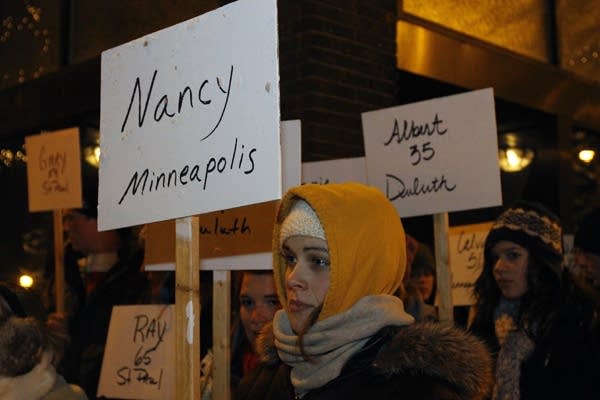In Minneapolis, hundreds mourn dead homeless
Go Deeper.
Create an account or log in to save stories.
Like this?
Thanks for liking this story! We have added it to a list of your favorite stories.

A quiet procession wound its way through the streets of Minneapolis on Thursday night to memorialize those who died while struggling with homelessness this year.
More than 400 mourners marched from the Hennepin County Government Center to Simpson United Methodist Church, many carrying white signs bearing a name of one of the 119 people who died: "Gary, 54, St. Paul," "Latrisha, 31, Minneapolis," or simply, "Unknown man, Minneapolis."
Many of those honored had lived for years without attracting much public attention, sleeping on shelter mats, living in rail yards, or setting up camps outside in the warmer months.
And many died where they had lived.
Turn Up Your Support
MPR News helps you turn down the noise and build shared understanding. Turn up your support for this public resource and keep trusted journalism accessible to all.
Bret Asfeld was found dead in a boxcar in Minneapolis last winter. Michael Palm was stabbed to death in his car, where he'd been living while working as a cab driver. Lori Calcutt went to bed one night at the Dorothy Day Center and never woke up.
Others died in hospitals or were found in the Mississippi River. Some killed themselves or were murdered. Some died of cancer or heart failure. Many were young, including a 6-month-old boy who died of sudden infant death syndrome, and a 23-year-old who died of an overdose.
"So many of the people that we're here to celebrate have no one," said social service worker Lindsay Becker. "And so we have to come here. It's our duty."

Some, like Becker, also came to share their memories at a packed memorial service held at Simpson United Methodist Church after the march.
More than 700 people listened as several speakers grieved the loss of Osman Axmed Afrah, a "relentlessly upbeat" man who loved to tell the story of the time he talked a stranger out of committing suicide.
"That's kind of the way he was with everyone at the shelter," said Robert Hofmann, an advocate at Simpson Housing Services.
Afrah had lived a tough life. Two years ago, he was severely beaten in the middle of winter and suffered frostbite while lying unconscious in the snow. Despite having several fingers amputated, he remained positive, friends said.

At last year's memorial service, Afrah found out that he was approved for subsidized housing. He moved into his new home and died in his sleep a few months later. He was 48 years old.
One man came to remember his friend, Marty Roan Eagle, who died at the age of 50.
"In another time, he would've been a medicine man," he told the somber crowd. "He had nothing. He was poor. But wow, he was powerful."
Many grieved the loss of Rural Bonner, a disabled man who died after being hit by a snowplow last winter.
Tim Cooper, a teacher at Hill-Murray School in St. Paul, spoke on behalf of his students who got to know Bonner while volunteering at a Minneapolis shelter.
"Everyone wanted to take care of him," Cooper said. "And he remembered everything." When Bonner learned that one of Cooper's students had been placed on the waiting list at MIT, he told her, "I just have a feeling that next week, you'll hear from the University of Michigan." And he was right.
The dead also included Tyrone Hicks, who moved to Minneapolis "with bullets still stuck in his body" to escape violence in Chicago, Sam Link, "a real gentleman" who always had a good joke to tell, and Robert Johnson, who joined a book club at a shelter and tried to convince the group to tackle a lengthy work by the philosopher Bertrand Russell.

An annual event
Simpson United Methodist Church started the annual memorial 25 years ago, in response to the death of a shelter resident named Eric, who had been missing for several days and was found beaten to death.
The Minnesota Coalition for the Homeless heard about the service and proposed that it become an annual event. Organizers decided to include the names of as many people as they could gather. This year's memorial also honored nine advocates and volunteers who died in the past year.
"Like with any memorial service, it provides an opportunity to be strengthened," said Julie Manworren, executive director of Simpson Housing Services. "And it's also a way to say that this just isn't okay. We're losing too many people."
Simpson Housing Services works with hospitals, medical examiners, and other social service agencies to collect the names of the deceased throughout the year. Organizers say that the list represents only a small portion of the total deaths in the homeless community, as the numbers are difficult to track.

Some fear next year could be worse
Many mourners said they worry that next year's list could be even longer, as the recession continues to harm the most vulnerable.
"It's just not right that we let people die like this," said Susan Montgomery, while marching up Nicollet Avenue with her five-year-old son. "It could've been anyone. It could've been me."
Five years ago, Montgomery had escaped an abusive partner and was homeless and pregnant. She had a job, but struggled to find an apartment because of a poor credit history.
"Finally, I pleaded and pleaded with this landlord," she said. "I told her, 'I do not want to give birth on the street, period.'"
The landlord relented and Montgomery moved in a few weeks before she gave birth. Now she said she wants her son to learn about the life she left behind.
"Maybe he's too young to understand," she said, as her son dug his hands into the snow. "But it's important that I try."



